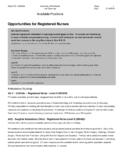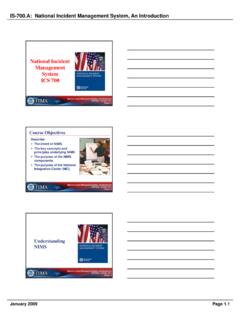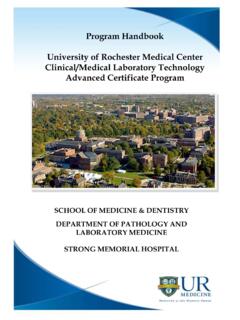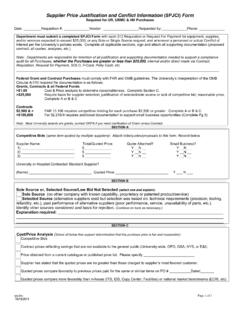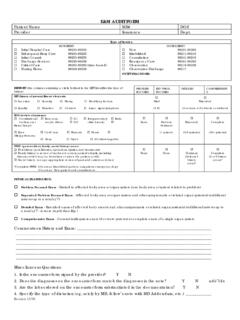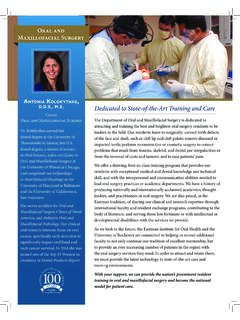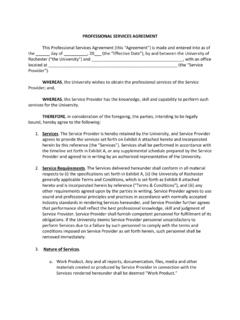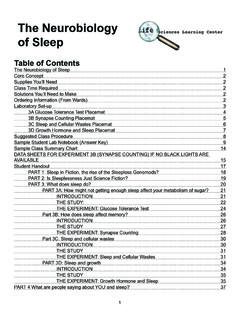Transcription of IDENTIFYING PRIORITIZING AND ADDRESSING CLIENT NEEDS ...
1 APRIL 2017. I DENTIFYING , P RIORITIZING AND A DDRESSING. C LIENT N EEDS : S TRATEGIES FOR H OME V ISITORS. Prepared By: P. Amina Alio, PhD. University of Rochester Medical Center, NYS Maternal & Infant Health Center of Excellence 265 Crittenden Blvd, Rochester, NY 14642 Tel: 585-276-7893 Fax: 585-461-4532. IDENTIFYING , PRIORITIZING and ADDRESSING CLIENT NEEDS Community Health Workers from the Maternal and Infant Community Health Collaborative (MICHC). programs and Home Visitors from the Maternal, Infant, and Early Childhood Visiting (MIECHV) programs exclusively work in community settings among primarily disadvantaged and vulnerable populations.
2 For simplicity in the rest of this report, the staff from these programs will be referred to as Home Visitors. While interacting with their clients, Home Visitors often encounter individuals with multiple and complex NEEDS ranging from lack of access to health care to social, economic and behavioral issues. Some of these NEEDS may fall within the scope of their roles and training, but other concerns may require referrals to clinical care providers or other resources.[1,2,3] This brief report highlights evidence-based and promising strategies to assist Home Visitors in IDENTIFYING , PRIORITIZING and ADDRESSING the multiple NEEDS of the women and families they serve.
3 Existing care prioritization or triage protocols are primarily designed for trained health care workers or licensed social workers. This process of prioritization of CLIENT NEEDS can be overwhelming, even for trained health or social service staff working in high need communities. For Home Visitors, it is even more challenging because they are not trained for, and not expected to conduct medical screenings or be able to identify specific health conditions. In addition, the process of PRIORITIZING NEEDS is continuous as clients'.
4 Status change: pregnancy or recent delivery, relationship status, living conditions, employment status, to name a few. The training and skills typically required for these decision-making processes are sometimes outside of the training and job scope of Home Visitors. Despite this, Home Visitors can be trained to serve as the initial contact for PRIORITIZING the multiple NEEDS of their clients. The following guidelines for use by Home Visitors have been adapted from nursing triage protocols and strategies, CLIENT engagement approaches, and strength-based models.
5 Approaches and Models To maximize the potential of Home Visitors' role, it is important to train them in the soft skills' of relationship building. Such skills are key to working with vulnerable clients and building their confidence and self-efficacy towards optimal health for themselves and their families. Training in CLIENT engagement, motivational interviewing , self-determination, and strengths-based approaches is important for Home Visitors as they work with clients to identify, prioritize and address NEEDS . CLIENT Engagement: IDENTIFYING strengths and NEEDS is a collaborative process between the Home Visitor and the CLIENT , as both have knowledge that, when shared and discussed, can provide the bigger picture of the CLIENT 's situation.
6 CLIENT engagement, similar to the concept of community engagement, is important for the process of IDENTIFYING CLIENT NEEDS and has several benefits. First, it communicates to the CLIENT that they are experts in their own life. Much research has shown that people living in poverty may internalize the stereotypes of others perceiving them to be weak, unmotivated, lazy, and so on. [4] By engaging them in the process, Home Visitors are indirectly ADDRESSING potential self-doubt or lack of autonomy, or any perception from the CLIENT that the Home Visitor is there to simply tell her what she's doing wrong and what she NEEDS to be doing right.
7 Secondly, it shows that the Home Visitor has respect for the CLIENT by seeking her input, a component which is important for building relationships based on trust. Thirdly, Maternal and Infant Health Center of Excellence 1. engaging the CLIENT in IDENTIFYING strengths and NEEDS can help build a two-way communication pattern that will help with future processes such as PRIORITIZING and setting goals for ADDRESSING those NEEDS . motivational interviewing : A practical skill for Home Visitors, motivational interviewing can be helpful in the process of IDENTIFYING , PRIORITIZING and ADDRESSING CLIENT NEEDS .
8 The 5 principles of motivational interviewing are [5]: 1. Express Empathy towards the CLIENT to show acceptance and build rapport. 2. Develop Discrepancy to enable the CLIENT to recognize that her present situation does not necessarily fit into her values, and what she would like in the future, and what changes she can make to address the discrepancy between her reality and her hopes. 3. Roll with Resistance to prevent a breakdown in communication between Home Visitor and CLIENT ;. allow the CLIENT to explore her views. 4. Support Self-Efficacy, an important component of change: when clients believe they have the ability to change, it is more likely that they will make the changes.
9 Self-Determination: The Self-Determination Theory is a theory of motivation and personality that addresses the universal psychological NEEDS of [6]: 1. Competence to seek to control the outcome and become the expert;. 2. Autonomy the universal urge to be in control of one's own life and act in harmony with one's self, while recognizing that this does not mean to be independent of others; and 3. Relatedness the universal desire to interact, be connected to, and experience caring for others. This theory suggests that there are two main types of motivation: external and internal.
10 With external motivation, a person tends to do something because they will obtain some form of reward or benefit;. whereas motivation that comes from within, from feeling that they have the competence, the autonomy and the relatedness necessary, is much more powerful and resulting changes are more long-term. Strengths-Based Approach: An important step during the conversations on CLIENT NEEDS is for the Home Visitor to also engage the CLIENT in IDENTIFYING her strengths, including the resources available to her. The CLIENT 's environment is often one where the NEEDS and negative aspects of her situation are more obvious and numerous.
